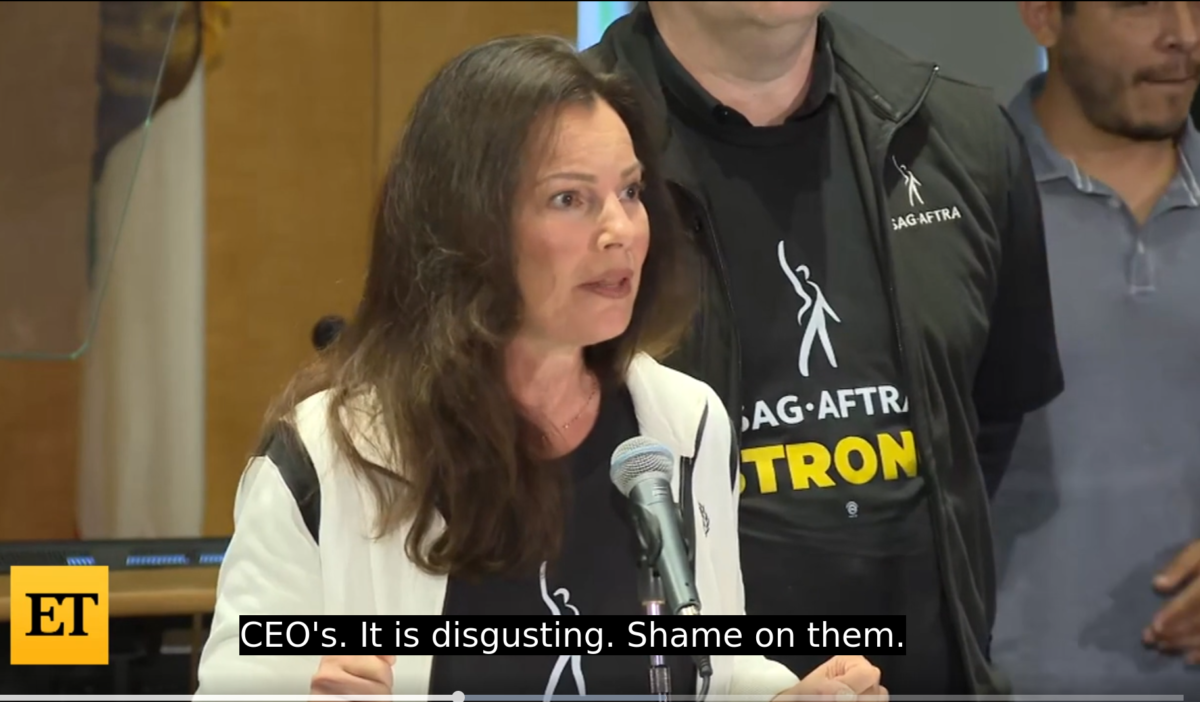Whatever you’re starting to binge-watch, slow down. It’s going to be a long wait for fresh content out of Hollywood.
Yesterday, the actors union, SAG-AFTRA, went out on strike alongside the members of the Writers Guild of America, who have been “>walking picket lines since May 2. Like the writers, actors have seen their livelihoods shrink as US TV shows’ seasons shorten, “reruns” that pay residuals fade into the past, and DVD royalties dry up, while royalties from streaming remain tiny by comparison. At the Hollywood and Levine podcast, the veteran screenwriter Ken Levine gives the background to the WGA’s action. But think of it this way: the writers and cast of The Big Bang Theory may be the last to share fairly in the enormous profits their work continues to generate.
The even bigger threat? AI that makes it possible to capture the actor’s likeness and then reuse it ad infinitum in new work. This, as Malia Mendez writes at the LA Times, is the big fear. In a world where Harrison Ford at 80 is making movies in which he’s aged down to look 40 and James Earl Jones has agreed to clone his voice for reuse after his death, it’s arguably a rational big fear.
We’ve had this date for a long time. In the late 1990s I saw a demonstration of “vactors” – virtual actors that were created by scanning a human actor moving in various ways and building a library of movements that thereafter could be rendered at will. At the time, the state of the art was not much advanced from the liquid metal man in Terminator 2. Rendering film-quality characters was very slow, but that was then and this is now, and how long before rendering moving humans can be done in high-def in real-time at action speed?
The studios are already pushing actors into allowing synthesized reuse. California law grants public figures, including actors, publicity rights that prevent the commercial use of their name and likeness without consent. However, Mendez reports that current contracts already require actors to waive those rights to grant the studios digital simulation or digital creation rights. The effects are worst in reality television, where the line is blurred between the individual as a character on a TV show and the individual in their off-screen life. She quotes lawyer Ryan Schmidt: “We’re at this Napster 2001 moment…”
That moment is even closer for voice actors. Last year, Actors Equity announced a campaign to protect voice actors from their synthesized counterparts. This week, one of those synthesizers is providing commentary – more like captions, really – for video clips like this one at Wimbledon. As I said last year, while synthesized voices will be good enough for many applications such as railway announcements, there are lots of situations that will continue to require real humans. Sports commentary is one; commentators aren’t just there to provide information, they’re *also* there to sell the game. Their human excitement at the proceedings is an important part of that.
So SAG-AFTRA, like the Writers Guild of America, is seeking limitations on how studios may use AI, payment for such uses, and rules on protecting against misuse. In another LA Times story, Anoushka Sakoui reports that the studios’ offer included requiring “a performer’s consent for the creation and use of digital replicas or for digital alterations of a performance”. Like publishers “offering” all-rights-in perpetuity contracts to journalists and authors since the 1990s, the studios are trying to ensure they have all the rights they could possibly want.
“You cannot change the business model as much as it has changed and not expect the contract to change, too,” SAG-AFTRA president Fran Drescher said yesterday in a speech that has been widely circulated.
It was already clear this is going to be a long strike that will damage tens of thousands of industry workers and the economy of California. Earlier this week, Dominic Patten reported at Deadline that the Association of Movie and Television Producers plans to delay resuming talks with the WGA until October. By then, Patten reports producers saying, writers will be losing their homes and be more amenable to accepting the AMPTP’s terms. The AMPTP officially denies this, saying it’s committed to reaching a deal. Nonetheless, there are no ongoing talks. As Ken Levine pointed out in a pair of blogposts written during the 2007 writers strike, management is always in control of timing.
But as Levine also says, in the “old days” a top studio mogul could simply say, “Let’s get this done” and everyone would get around the table and make a deal. The new presence of tech giants Netflix, Amazon, and Apple in the AMPTP membership makes this time different. At some point, the strike will be too expensive for legacy Hollywood studios. But for Apple, TV production is a way to sell services and hardware. For Amazon, it’s a perk that comes with subscribing to its Prime delivery service. Only Netflix needs a constant stream of new work – and it can commission it from creators across the globe. All three of them can wait. And the longer they drag this out, the more the traditional studios will lose money and weaken as competitors.
Legacy Hollywood doesn’t seem to realize it yet, but this strike is existential for them, too.
Illustrations: SAG-AFTRA president Fran Drescher, announcing the strike on Thursday.
Wendy M. Grossman is the 2013 winner of the Enigma Award. Her Web site has an extensive archive of her books, articles, and music, and an archive of earlier columns in this series. Follow on Mastodon.

2 thoughts on “Solidarity”